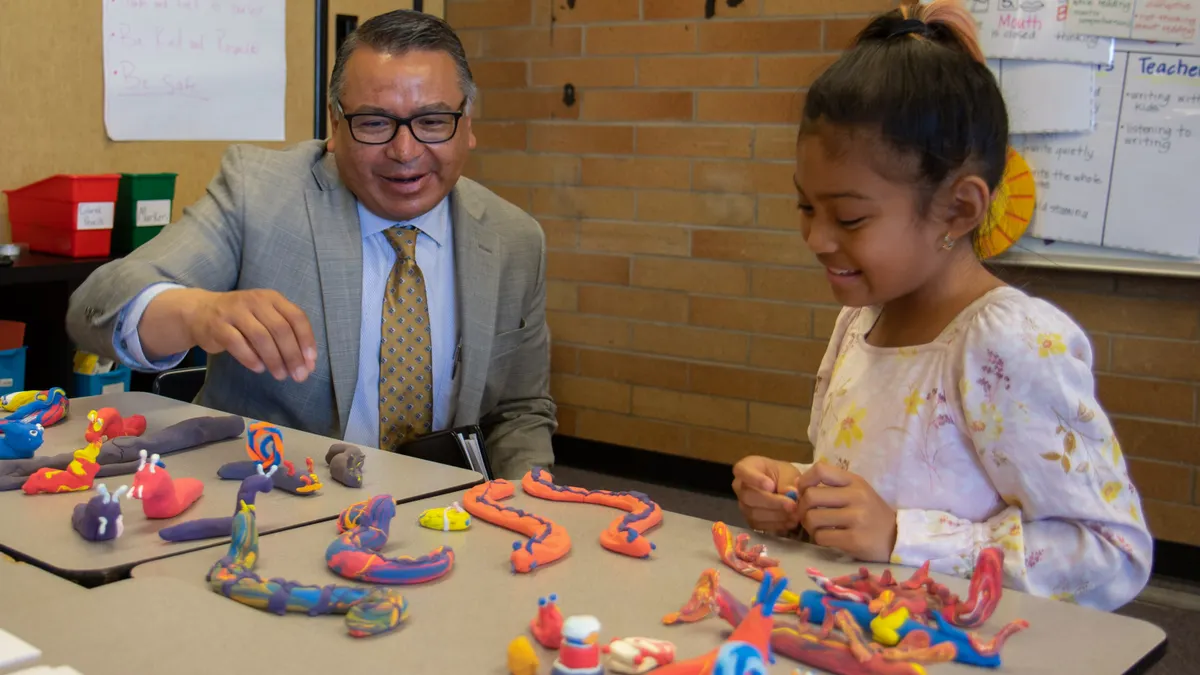WASHINGTON — Brookside Primary School in Waterbury, Vermont, used part of its federal COVID-19 emergency funds to create a kindergarten interventionist position to support teachers in developing their young students' math and literacy skills.
The principal of Henderson Middle School in Jackson, Georgia, said her school invested its allocation toward strengthening relationships between students, staff and families so the school's culture could become one that is welcoming and supportive.
And in Indianapolis Public Schools, the district's spending on tutoring initiatives has resulted in substantial academic gains for participating students.
These examples of return-on-investment success stories from the one-time Elementary and Secondary School Emergency Relief fund were shared during a convening of the Coalition to Advance Future Student Success on March 20 in Washington, D.C.
The coalition includes 12 education organizations, such as the Council of Chief State School Officers and AASA, The School Superintendents Association, that encourage school systems to maintain the school improvement momentum that was buoyed by $189.5 billion in federal ESSER funds.
Understanding why some investments worked and others didn't is key to developing future funding streams to sustain improvement programs that began under ESSER, education leaders said. States and districts must obligate all their ESSER funds by Sept. 30.
The classroom
Jo-Anne Smith has spent the last two years as a kindergarten intervention specialist at Brookside Primary, where she helps kindergarten teachers analyze assessment data, supports early literacy activities, and models classroom instructional practices for teachers.
Her position was funded through ESSER dollars, and even though her role is expected to expire with the end of the relief funds, she said her work has been a vital boost to teachers and students. Before her current position, Smith was a 1st and 2nd grade teacher at the school.
Through providing evidence-based interventions for teachers and students, Smith is hopeful instructional practices will be sustained, and that she's helped teachers build their capacity to support early learners.
"It's been such a great experience for me to have that time and bandwidth, not having my own classroom, to support teachers and also be a leader in my district around literacy," Smith said.
The school
When the pandemic caused widespread school closures in spring 2020, Suzan Harris, principal of Henderson Middle School said she almost quit. Instead, she learned how to navigate the new situation and vowed to use her school's ESSER funds to improve social-emotional wellbeing at the school.
Before the pandemic "kids were coming into our school everyday and struggling," Harris said. Carter Glover, now an 8th grader, said she was scared to visit the school because an older sibling told her about frequent fights in the cafeteria.
Harris and other staff worked to improve student-student, student-adult and adult-adult relationships at the school. The school also gauged students' social-emotional status, created small group counseling sessions, and helped teachers with classroom management.
Other changes are helping create a more positive school culture, Harris said. Those include arranging group seating in the cafeteria for students to interact with each other and their teachers, and implementing a system for students to feel comfortable talking to adults in school about issues they’re concerned about.
Carter agreed that the cafeteria is a more calm place. "Nothing really happens in the lunchroom. People are minding their own business."
Because of the approaches the school has taken, office referrals have significantly dropped, from 1,536 in the 2018-19 school year to 589 in the 2022-23 school year.
Still, the data shows there are still areas of need, and the school is planning to sustain its investments through professional development for newly hired educators, Harris said.
She said the school is now committed to catering to students' social-emotional learning needs. "We would have never had that opportunity if we didn't get funding from ESSER to put toward training teachers in that area," Harris said.
The districts
Adam Kunz, assistant superintendent of Minnesota’s St. Paul Public Schools, and Andrew Strope, deputy superintendent of Indianapolis Public Schools, shared how their districts invested in learning recovery, and how they plan to carry those efforts forward — even after ESSER funds run out.
In Indianapolis, the district has used ESSER money to launch a multi-year reorganization plan that aims to provide a more robust student experience for all students, including academic supports and increased access to band, world language courses and higher-level classes, Strope said.
For example, 41% of the district's middle school students have access to Algebra I, but the goal is 100% access.
With its tutoring initiatives, the district has seen "substantial and sustained growth," according to a slide Strope shared.
The district has also focused its efforts on improving access to higher performing schools in the district that have traditionally been located in higher-income areas.
But the district had to go through the "painful process" of school consolidations starting this school year due to efficiency and economical factors, Strope said.
"You have to confront the brutal facts without losing hope," Strope said.
Despite the school closures, there has been a 146% increase in out-of-district enrollment applications for the 2024-25 school year.
"A lot of this is about trying to make our offerings aligned with what families want and really trying to be competitive," Strope said.
In St. Paul, Kunz said the school district facilitated over 10,000 community meetings, surveys and other outreach that helped the school system narrow its focus for ESSER spending on literacy, safety and sense of belonging, and respectful and reflective schools.
Kunz said the district is attempting to take the most effective pandemic-era approaches and maintain those. For example, the district created summer learning programs featuring hands-on and outdoor activities. Its traditional high school credit recovery programs, however, were less engaging.
Now, the district is building a more experiential credit recovery program featuring all-day field trips and exposure to different activities.
"I don't know why it took a pandemic for that light bulb to go off," Kunz said.

The state
North Carolina Superintendent of Public Instruction Catherine Truitt shared how early ESSER investments targeted safe return-to-school approaches. Later ESSER allocations were funneled more toward learning recovery and teacher retention.
The state received $3.6 billion in K-12 American Rescue Plan funds, also known as ESSER III .
Truitt said analyzing data such as summer school attendance and academic progress helped state leaders better understand where the needs were. The data, for example, guided the state to prioritize middle school math programs, efforts to bridge students' transitions to middle and high schools, and literacy instruction, Truitt said.
Research into assessment data shows encouraging progress in 3rd graders' reading proficiency, with an overall improvement of 95% between 2021 and 2023. Those 3rd graders, Truitt said, missed all of kindergarten and half of 1st grade due to the pandemic. She added the gains are evident across different student racial populations.
To help districts plan for the end of ESSER funding, the state created a funding cliff toolkit and a district-level spending dashboard that also shows grade level learning recovery progress.
Truitt and state Sen. Michael Lee emphasized the importance of the legislature and state education agency working together to ensure funding is directed to programs demonstrating a positive impact, and that spending is approached with equity in mind.
Truitt added that "having very specific asks that are backed by data" is a recommended practice when approaching lawmakers with funding requests.
Ultimately, education leaders need to help lawmakers "filter out the noise" and "help show them how to put kids at the center" of decisions, Truitt said.







 Dive Awards
Dive Awards










